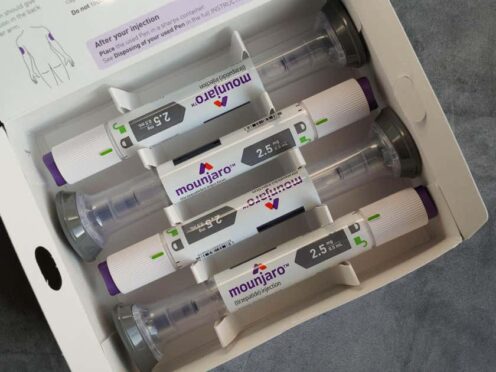
The type 2 diabetes drug Mounjaro has been recommended to help obese people lose weight on the NHS.
Mounjaro – also known as tirzepatide and made by Eli Lilly – is a glucagon-like peptide-1 (GLP-1) agonist, a family of medications that help manage blood sugar.
Other GLP-1 agonists include semaglutide – sold under the brand names Wegovy, Ozempic and Rybelsus.
In September, the National Institute for Health and Care Excellence (Nice) recommended Mounjaro as an option for type 2 diabetics who could not tolerate metformin.
It has now issued draft guidance saying the drug should also be an option to help people manage obesity.
It comes after the Medicines and Healthcare products Regulatory Agency (MHRA) authorised Mounjaro to be used to help obese adults with weight loss in November.
Subject to final guidance, the once-weekly jab will be recommended for patients with a body mass index (BMI) of 35 with at least one obesity-related condition.
It should be prescribed alongside a reduced-calorie diet and exercise, Nice said.
A lower BMI threshold – usually reduced by 2.5kg (5.5lb) – may be used for people from Asian, South Asian, Chinese, Middle Eastern, black African or African-Caribbean ethnic backgrounds.
The Nice guidance said Eli Lilly proposes that the drug should be available to those with a BMI of 30 with at least one weight-related condition.
However, the NHS spending watchdog said “most likely cost-effectiveness estimates for this group are above the range that Nice considers an acceptable use of NHS resources”.
An Eli Lilly spokesman said the company is “pleased with the progress in the Nice process” and “the consultation process is ongoing, with another committee meeting scheduled for August 13”.
Reacting to the publication of the draft guidance, Sir Stephen O’Rahilly, a professor of clinical biochemistry and medicine and the director of the Medical Research Council Metabolic Diseases Unit at the University of Cambridge, said drugs like Mounjaro “will become a central plank of how we help people living with obesity to live longer and healthier lives”.
He added: “Given the very positive recent results of large, randomised control trials with this drug and its beneficial effects on a range of outcomes, this decision is not surprising.
“We are clearly in a new era of obesity management where, for the first time, we can have access to medicines which are effective and, though not without some side-effects, largely safe.”
The Nice recommendation on Mounjaro comes after Wegovy was given the green light to treat obesity on the NHS last year.
The drug was launched in the UK in August and is recommended for those with at least one obesity-related condition and a BMI of 35, or 30 if they meet the criteria for a referral to specialist weight management services.
A four-week supply of pre-filled pen injections of Mounjaro ranges from £92 for the lowest dose to £122 for the highest.
The price of Wegovy ranges from £73.25 to £175.80 per pack, with each pack containing one pen that delivers four doses.
However, Wegovy manufacturer Novo Nordisk has a commercial arrangement which makes it available to the NHS at a discount.
It is understood there is no agreement in place for Mounjaro.
Prof Sir Stephen added: “This class of injectable drug is currently expensive, providing particular challenges to a taxpayer-funded health system like the NHS.
“In the longer term, these drugs significantly reduce the risks of developing distressing and expensive complications such as type 2 diabetes, heart attacks and kidney failure but their cost provides an immediate financial challenge at a time when NHS budgets are tight.”

Enjoy the convenience of having The Sunday Post delivered as a digital ePaper straight to your smartphone, tablet or computer.
Subscribe for only £5.49 a month and enjoy all the benefits of the printed paper as a digital replica.
Subscribe